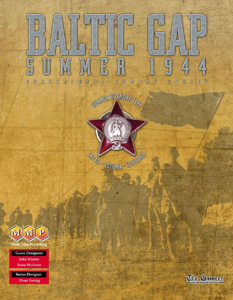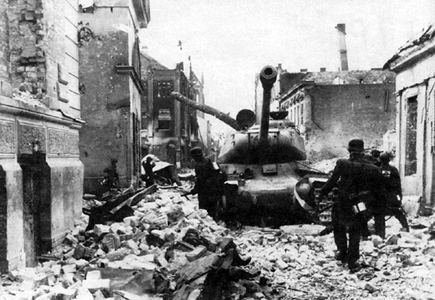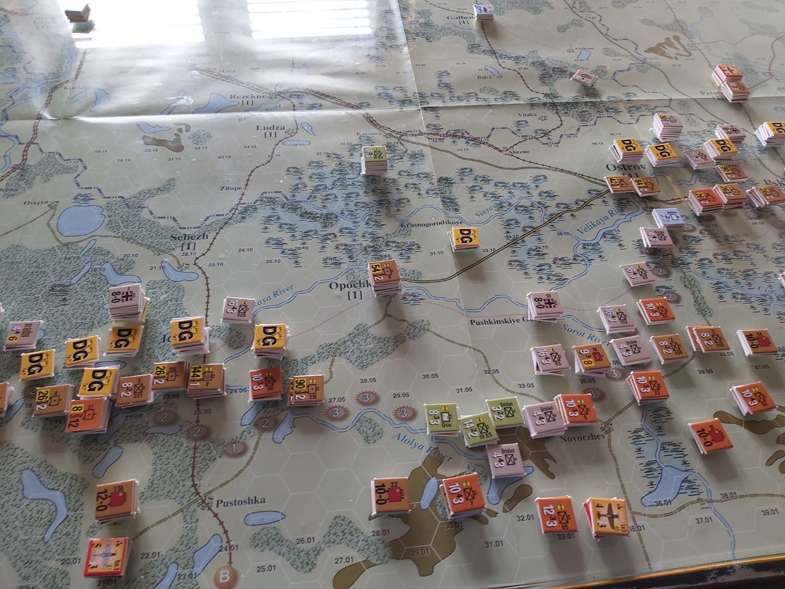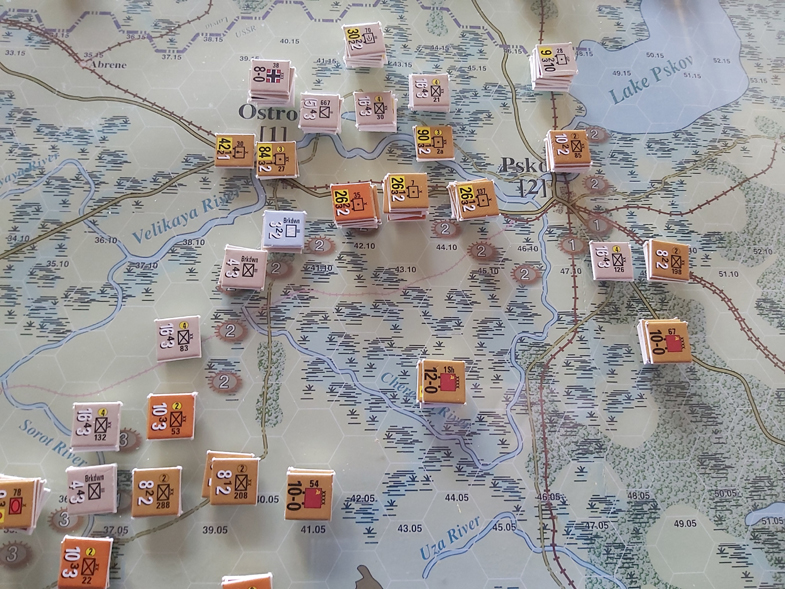 |
 |
WARGAMESOSD Baltic Gap - Summer 1944 |
 |
 |
| Baltic Gap: Summer 1944, depicts the Soviet drive into Latvia, Estonia, and Lithuania during the summer of 1944. As the game begins, the defense of Vitebsk, a Byelorussian fortified city located just a few hexes beyond the southeast corner of the playing surface, has just collapsed. 1st Baltic Front is advancing westward through the shredded German line, and will soon threaten all of Army Group North with encirclement. Finally, after four months of fierce battle, the Red Army will win the great prize of this campaign, Riga, and pocket the enemy in the Courland region of Latvia. (from boardgamegeek.com) |
 Game play on 5th July 1944 - many Axis units disorganised (DG) - 1st and 2nd Baltic Fronts in pursuit. |
| Game
Mechanics Time Scale: 3 - 4 days 26th June - 29th October 1944) Map Scale: 2 miles (3.25 km) Unit Scale: battalion to army Players: Two - High complexity Solitaire Suitability: High complexity Playing Time: 200+ hours (full campaign only) |
Scenarios |
|
Game
components: |
Game
Strategy Published by MMP using their OCS (Operation Combat System) rules, which is more complex than most. This game includes two rules booklets of 48 pages each, one OCS and one game specific with scenarios and OB's |
 Game play on 5 July 1944 - Axis retreat at Ostrov and Pskov, the 3rd Baltic Front shadowing with heavy artillary |
|
wargames.wilkey.org.uk
|
|
|
|
|
Some personal
comments of a new player to OCS rules 'Trace supply' is easy because it works the same as any other game, tracing to the edge of the map and so on. One good innovation is the various comments/reminders that permeate the reinforcement schedules, such as new supply points (for the Soviets) or the release of the resources from the Saaremaa, Narva and Kaunas boxes (which are substantial). The only real complaint about the reinforcements schedule is that it includes withdrawals (which are, of course, historically correct), but how do you withdraw units where there are maybe 800 or more tiles in play and you haven't a clue where they are - you cannot turn over every tile to look for them otherwise you would never finish the game? Air units are easier to withdraw. REs (regimental equivalents) could be simpler (4.6 of the general rules) and there is a danger of over-stacking as a result. The role or application of partisans is not explained in the general rules, only the specific ones (see 1.10 Variable reinforcements), their effect is to create 'train-busting' markers. See 14.8 of the general rules for train-busting effects. The game could have provided more charts, the ones provided are the CRT (Combat Results Table) and the 'Barrage' charts as well as 'Flak', (4 pages printed in booklet form, one for each player), a piece of paper on the Sequence of Play. Other charts are found in the rules booklets. For myself I copied the following tables on to 150 gsm card for convenience of use: 1) Common Rebuild
Table, Shipping Capacities, Event Table and German & Soviet Supply
Tables from page 47 of the specific rules. The following other notes may prove useful: Axis colour codes Kreigsmarine: Mauve Russian air/navy Salmon/yellow border
= LRAF (10) Red Latvia Tan/Orange
+ green (2) Kaunas Items marked PG are found in the full panzer division sections (4, 5 &14), each identified by a colour stripe - dark blue (4 pz), orange (5 pz) & salmon (14 pz) Garrison (Gar) units These units, awarded to the Axis player in the Reinforcement phase (see also German Repl. Table). They are those units marked 'Alert' or some units with the anti-tank symbol (see 2.5 of the specific rules) One interesting aspect of the game is that the Baltic forces of Estonia, Lithuania and Latvia fought on both sides of the conflict. The difference between the two sides is that the Soviet units use the same colour code as the Axis, but in the form of a stripe, not the whole colour of the tile of the Axis. |